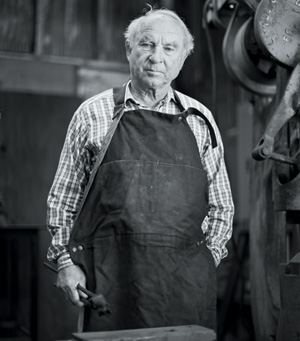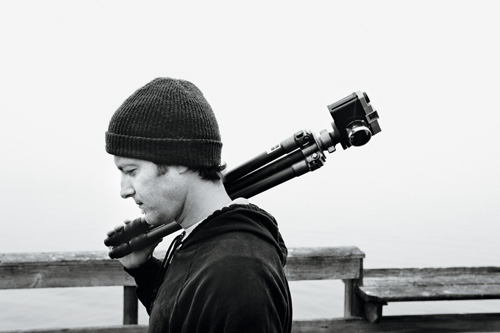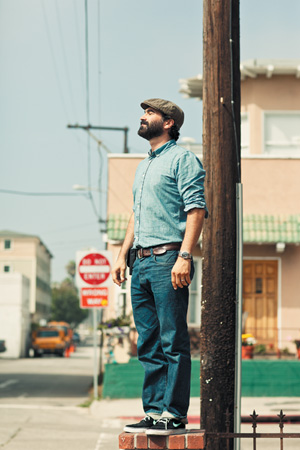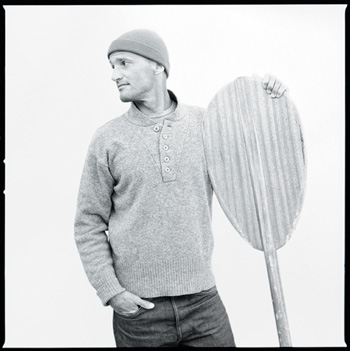23. Be Who You Are

OPPOSITE Yvon Chouinard was an early climbing pioneer in Yosemite and made several important first ascents. Not satisfied with the available gear, he used his blacksmith skills to build his own. His gear and approach caught on like wildfire, and he started the company Patagonia. Chouinard is the real deal. Fifty years later, he stands in his original workshop and he is still as tough as steel.
Canon 5DMii, 50mm lens, f/2
WHEN I WAS A CHILD, the neighborhood group of boys defined a poser as someone who pretended or falsely played the part. In skateboarding that meant if your board was not scratched it was not authentic. And you had to have a few scars from skinning your knees, too. More than anything I wanted those scratches and scars.
One summer afternoon, my grandfather and I walked into the small skateboard and baseball card shop in my town. The front door was plastered with stickers. The biggest sticker proclaimed, “No Posers Allowed!” My eight-year-old heart pounded as I walked into this boyhood sanctuary of stuff and looked up at the walls covered with posters, hats, bats, balls, wheels, decks, and gear. Grandpa and I looked everything over carefully and then he bought me my first skateboard. This was the real deal. With this skateboard I was on my way.
Risk of Taking Portraits
Ever since those early skateboarding days, I’ve always had an adverse reaction to the photographic portrait concept of posing—it just seemed too awkward and unreal. And in most photographs, it is. The typical posing techniques are overdone, making the subject appear like he is trying too hard. What’s worse is that the lack of authenticity prevents the picture from making its way from our eyes to our heart. It may be a perfect picture from a technical standpoint, but it definitely didn’t capture the character, essence, or soul of the subject.
Here’s where we discover the crux of it—admitting that making pictures of people is a risky task. Henri Cartier-Bresson once said, “It seems dangerous to be a portrait artist... because everyone wants to be flattered, so they pose in such a way that there’s nothing left of the truth.” Yet, it is a risk worth taking, like skateboarding down a steep hill. If we get it right, the rush is an authentic and incomparable thrill.

Joe Curren’s photography has an understated and poetic style. His pictures convey subtle beauty, solitude, and peace. One morning after shooting some landscapes, I captured this frame as we returned to our cars.
Canon 5DMii, 16–35mm lens, f/5.6
Exercise: Capturing Poise and Personality
The fastest way to improve your people pictures is to say something that is true. Rather than asking a subject to pose and pretend, draw out who he or she really is. Direct and lead but do not overbear. Every person projects a distinct poise, posture, and personality. Even when it comes to staging a shoot, let that shine and you will capture something that isn’t just surface deep.
For this exercise, I want you to begin to think about the theater of life. If life is a stage with actors, props, and backdrops, how could you use what is already there in order to tell a tale?
Step 1 Selecting a Subject
Choose a person to photograph whom you are comfortable with and know well. Seek out someone who has personality and depth. Perhaps you know an ambitious athlete, avid sports fan, enthusiastic hobbyist, or intriguing musician. Ask to photograph the subject in a location that reflects what he does.
Step 2 Directing the Subject
Photographer Rodney Smith begins most of his shoots the same way. He explains to the subject, “I don’t want you to model. I want you to be you.” Try this out. Explain that you are interested in creating a photograph that is natural so the subject doesn’t need to try too hard.
Tips
Visit your local thrift, used sports, or army surplus stores to look for props that might work.
Rather than pose your subject, ask him to move naturally. Encourage him to change up his posture and position at a moderately quick pace.
Using props can be risky because the pictures can seem forced and trite. The solution is to keep it natural and try to create pictures where the prop fits right in. If you make a few mistakes, that is OK. Keep shooting until you’ve created something you like.
As a director, take a playful and less controlling tone. Convey a sense that you don’t have everything figured out but that you have some fun ideas. Begin by asking the subject to do what he does. If he is a musician, ask him to play one of his songs.
Step 3 Setting the Stage
Choose a location that is natural and conducive to getting your subject to play a natural part. Imagine that you are creating a scene from a play or movie of his life and that you want everything to fit just right. Look for any distracting elements that might be in the frame and move them out.
Step 4 Working with Props
I want you to try two approaches with props. First, the best props are those that are found. Look in the natural environment for the shoot. Is there anything interesting and meaningful that could work? Second, try using something that you have brought along. Consider bringing an item that is unique, such as a vintage bike, an empty picture frame, a tennis racket, a typewriter, or an old wooden oar. Make sure it is a prop that fits naturally within the frame. Shoot for 30 minutes with the goal of capturing ten strong pictures.
Exercise Details
Goal: 10 portraits. Tools: Camera; normal or telephoto focal-length lens. Light: Natural or available light. Location: An environment that reveals who the subject is or what the subject does. Theme: The subject as an authentic performer on the stage of life. Duration: 35 minutes.

LEFT Jeff Lipsky closes his eyes and absorbs the morning sun a few blocks from his house in Venice Beach. Before asking him to look my way, I caught this small, natural moment.
Canon 5DMii, 85mm lens, f/3.2
Step 5 Wrapping Up Strong
End the shoot on a high note and express your gratitude for the subject’s time. Be sure to compliment the subject on what it is that he does and how that was expressed throughout the photo shoot. As a final wrap-up note, give him a warm handshake and let him know when he can expect to see the shots.
OPPOSITE The oversized outrigger paddle was sitting in the garage. A perfect prop to create a classic and story-filled frame.
Hasselblad 503CW, 80mm lens, f/5.6, Tri-X Black and White Film
“People aren’t going to remember the things that you do. They are going to remember how you made people feel.”
—Dan Winters

